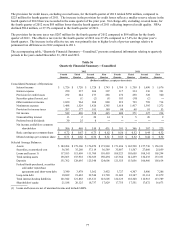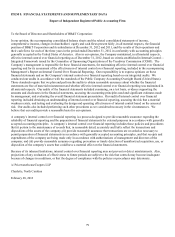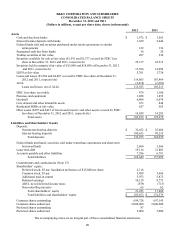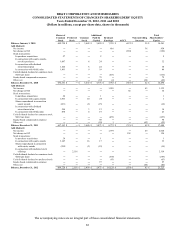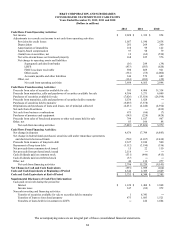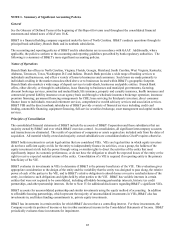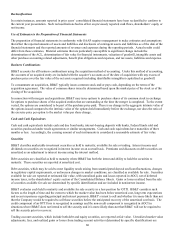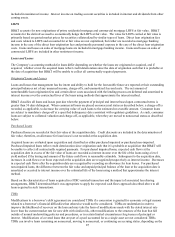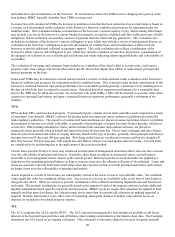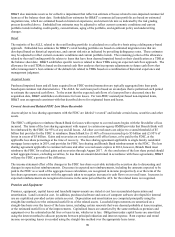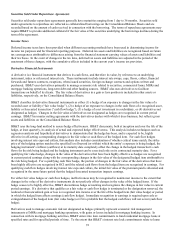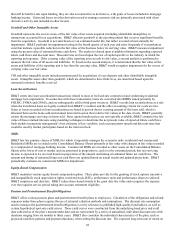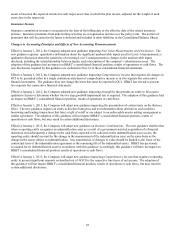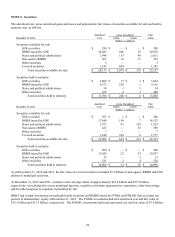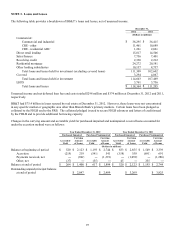BB&T 2012 Annual Report Download - page 109
Download and view the complete annual report
Please find page 109 of the 2012 BB&T annual report below. You can navigate through the pages in the report by either clicking on the pages listed below, or by using the keyword search tool below to find specific information within the annual report.
87
included in noninterest income. Interest income on trading account securities is included in interest and dividends from other
earning assets.
LHFS
BB&T accounts for new originations of prime residential mortgage and commercial mortgage LHFS at fair value. BB&T
accounts for the derivatives used to economically hedge the LHFS at fair value. The value for LHFS carried at fair value is
primarily based on quoted market prices for securities collateralized by similar types of loans. Direct loan origination fees
and costs related to LHFS and accounted for at fair value are not capitalized, but rather are recorded as mortgage banking
income in the case of the direct loan origination fees and primarily personnel expense in the case of the direct loan origination
costs. Gains and losses on sales of mortgage loans are included in mortgage banking income. Gains and losses on sales of
commercial LHFS are included in other noninterest income.
Loans and Leases
The Company’ s accounting methods for loans differ depending on whether the loans are originated or acquired, and if
acquired, whether or not the acquired loans reflect credit deterioration since the date of origination such that it is probable at
the date of acquisition that BB&T will be unable to collect all contractually required payments.
Originated Loans and Leases
Loans and leases that management has the intent and ability to hold for the foreseeable future are reported at their outstanding
principal balances net of any unearned income, charge-offs, and unamortized fees and costs. The net amount of
nonrefundable loan origination fees and certain direct costs associated with the lending process are deferred and amortized to
interest income over the contractual lives of the loans using methods that approximate the interest method.
BB&T classifies all loans and leases past due when the payment of principal and interest based upon contractual terms is
greater than 30 days delinquent. When commercial loans are placed on nonaccrual status as described below, a charge-off is
recorded, as applicable, to decrease the carrying value of such loans to the estimated recoverable amount. Consumer loans
are subject to mandatory charge-off at a specified delinquency date consistent with regulatory guidelines. As such, consumer
loans are subject to collateral valuation and charge-off, as applicable, when they are moved to nonaccrual status as described
below.
Purchased Loans
Purchased loans are recorded at their fair value at the acquisition date. Credit discounts are included in the determination of
fair value; therefore, an allowance for loan losses is not recorded at the acquisition date.
Acquired loans are evaluated upon acquisition and classified as either purchased impaired or purchased non-impaired.
Purchased impaired loans reflect credit deterioration since origination such that it is probable at acquisition that BB&T will
be unable to collect all contractually required payments. For purchased impaired loans, expected cash flows at the
acquisition date in excess of the fair value of loans are recorded as interest income over the life of the loans using a level
yield method if the timing and amount of the future cash flows is reasonably estimable. Subsequent to the acquisition date,
increases in cash flows over those expected at the acquisition date are recognized prospectively as interest income. Decreases
in expected cash flows after the acquisition date are recognized by recording an allowance for loan losses. For purchased
non-impaired loans, the difference between the fair value and unpaid principal balance of the loan at the acquisition date is
amortized or accreted to interest income over the estimated life of the loans using a method that approximates the interest
method.
Based on the characteristics of loans acquired in a FDIC-assisted transaction and the impact of associated loss sharing
arrangements, BB&T determined that it was appropriate to apply the expected cash flows approach described above to all
loans acquired in such transactions.
TDRs
Modifications to a borrower’ s debt agreement are considered TDRs if a concession is granted for economic or legal reasons
related to a borrower’ s financial difficulties that otherwise would not be considered. TDRs are undertaken in order to
improve the likelihood of recovery on the loan and may take the form of modifications made with the stated interest rate
lower than the current market rate for new debt with similar risk, other modifications to the structure of the loan that fall
outside of normal underwriting policies and procedures, or in certain limited circumstances forgiveness of principal or
interest. Modifications of covered loans that are part of a pool accounted for as a single asset are not considered TDRs.
TDRs can involve loans remaining on nonaccrual, moving to nonaccrual, or continuing on accruing status, depending on the


